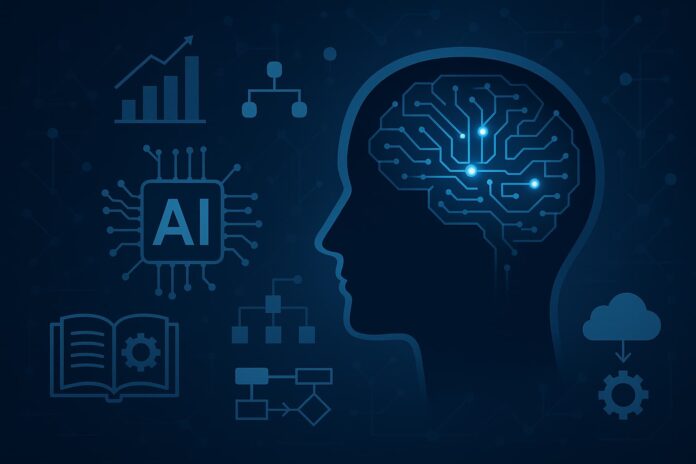Artificial Intelligence (AI) is transforming the world faster than any innovation before it. From the smartphone in your hand to the navigation in your car and even the movies recommended to you online — AI quietly powers countless everyday decisions. But how do these machines actually “learn,” “think,” and “decide”? This comprehensive guide unpacks the science, logic, and creativity behind artificial intelligence, exploring how algorithms evolve from data and how machines are beginning to understand — and even predict — the complexities of human life.
Introduction
Artificial Intelligence is no longer confined to laboratories or science-fiction stories; it is the invisible engine running our modern world. When your phone unlocks using your face, when a streaming service predicts what you’ll watch next, or when a medical AI scans X-rays faster than a radiologist — you’re witnessing intelligent computation at work. AI operates behind the scenes, translating enormous amounts of data into insights and decisions that make our lives easier, safer, and more efficient.
At its essence, AI is humanity’s attempt to teach machines to “think” — to process information, interpret situations, and respond intelligently. What makes this pursuit extraordinary is that machines don’t learn as humans do; they learn from vast quantities of data, extracting statistical relationships that allow them to improve autonomously. The result is a digital mind capable of identifying fraud, diagnosing disease, composing music, and even simulating emotion.
In this article, we’ll explore every aspect of this intelligence — how it’s created, how it learns, and how it decides — along with the ethical, social, and creative implications that accompany a technology powerful enough to reshape civilisation itself.
1. What Is Artificial Intelligence?
Artificial Intelligence refers to computer systems engineered to perform cognitive tasks that typically require human intelligence — such as reasoning, perception, problem-solving, and learning. Instead of simply executing commands, AI systems adapt based on patterns and outcomes, continuously refining their performance.
The modern concept of AI originated with Alan Turing’s question in 1950 — “Can machines think?” — leading to decades of research in logic, computation, and neuroscience. Today, AI underpins technologies that interpret human speech, diagnose illnesses, and power financial markets.
AI is classified into three main types:
- Narrow AI (Weak AI): Performs specific tasks like spam detection or face recognition.
- General AI (Strong AI): Would understand, reason, and learn across multiple domains — like a human.
- Superintelligent AI: A theoretical future form surpassing human reasoning and creativity.
The AI we use today may be “narrow,” but it is extraordinarily effective — proving that intelligence, in any form, is ultimately the ability to learn, adapt, and make decisions.
2. How Machines Learn: The Core of Machine Learning
Machine Learning (ML) is the beating heart of AI — the method by which computers learn from data and experience. Rather than relying on fixed rules, ML systems detect patterns, test predictions, and refine their algorithms based on feedback. This ability to “learn” has enabled machines to master speech recognition, product recommendations, fraud detection, and autonomous driving.
Main Learning Techniques Explained
- Supervised Learning: Machines learn from labelled data — examples with known answers. Think of it as showing the system many flashcards until it recognises what each card depicts. This technique powers email spam filters and predictive text.
- Unsupervised Learning: No labels are provided; the system groups or organises data on its own. It’s how platforms like Spotify or Amazon segment users by preference without explicit instructions.
- Reinforcement Learning: The AI learns through trial and reward, much like training a dog. It takes actions, measures outcomes, and adjusts to maximise “rewards.” This approach drives robotics and game-playing systems like DeepMind’s AlphaGo.
The brilliance of machine learning lies in feedback loops — the ability to improve autonomously as more data becomes available.
| Learning Type | Core Idea | Examples | Real-World Application |
|---|---|---|---|
| Supervised | Learn from labelled data | Linear regression, decision trees | Email filtering, forecasting |
| Unsupervised | Discover hidden structures | Clustering, PCA | Customer segmentation |
| Reinforcement | Learn via feedback | Q-learning | Self-driving vehicles |
Every great AI begins as a student — one that learns tirelessly, 24/7, from billions of experiences.
3. Thinking Like a Human: The Role of Neural Networks
At the core of how machines “think” lies a structure inspired by the human brain: the Artificial Neural Network (ANN). These interconnected nodes simulate the behaviour of neurons, passing information through layers that transform raw data into meaningful patterns.
A neural network receives input (like an image), processes it through hidden layers that extract key features (edges, colours, shapes), and delivers an output (e.g., “This is a cat”). Each connection between nodes has a weight — a mathematical value adjusted during training to reduce error, a process known as backpropagation.
Key Concepts Simplified
- Input Layer: Feeds raw data into the system.
- Hidden Layers: Discover relationships, patterns, or abstractions.
- Output Layer: Produces final predictions or classifications.
- Activation Functions: Help determine which signals are important.
When your phone recognises your face, neural networks are comparing minute features like distance between eyes or jawline curvature — all learned through millions of samples. Machines don’t see “faces”; they see numbers, patterns, and probabilities — and through training, those patterns become decisions.
4. Deep Learning: The Engine of Modern AI
Deep Learning is the powerhouse behind today’s AI revolution. It extends neural networks into many layered structures capable of interpreting complex, unstructured data such as images, audio, and language. This is the technology behind Siri, Google Translate, autonomous vehicles, and even ChatGPT itself.
Each layer in a deep network learns progressively more abstract features. The first might detect edges, the next shapes, and higher layers concepts like “faces” or “objects.” This hierarchical learning mimics how the human brain processes information.
Types of Deep Learning Models
- Convolutional Neural Networks (CNNs): Specialised in visual data — ideal for facial recognition or medical imaging.
- Recurrent Neural Networks (RNNs): Designed for sequences like speech or time-series data.
- Transformers: Modern architectures that power generative AI — capable of contextual understanding and text generation.
Deep Learning eliminates manual programming. Instead, it discovers the features that matter most — enabling AI to perform tasks that once seemed exclusive to human intelligence.
| Model | Strength | Applications |
|---|---|---|
| CNN | Visual analysis | Radiology, self-driving cars |
| RNN | Sequential data | Speech recognition, stock forecasting |
| Transformer | Contextual learning | Chatbots, content generation |
5. How Machines Make Decisions
Learning patterns is one thing; deciding what to do with them is another. Decision-making in AI involves weighing possibilities, predicting outcomes, and selecting the optimal action.
AI decision systems use a combination of logic, probability, and optimisation to simulate human reasoning. They can analyse thousands of scenarios per second, evaluating which choice offers the best result — whether it’s recommending a movie or steering an autonomous vehicle safely through traffic.
Core Decision Models
- Decision Trees: Divide information into branches leading to the best choice.
- Bayesian Networks: Calculate the probability of outcomes under uncertainty.
- Reinforcement Learning Agents: Learn to maximise rewards through repeated experience.
- Fuzzy Logic Systems: Handle ambiguity — for example, “somewhat true” or “very likely.”
Autonomous drones, trading bots, and medical diagnostic systems all rely on decision models — not just to compute, but to judge among multiple competing answers, much like humans do instinctively.
6. Data: The Lifeblood of AI
Without data, AI is like a brain without experience. Every prediction, insight, or decision originates from analysing data. The amount, quality, and diversity of this data determine how “intelligent” a system becomes.
Types of Data in AI
- Structured Data: Clean, numerical, and organised — like financial records or sensor readings.
- Unstructured Data: Free-form — images, speech, social media, emails.
- Semi-Structured Data: A mix, such as web logs or metadata.
| Data Type | Format | Processing Tool | Common Use |
|---|---|---|---|
| Structured | Tables, numbers | SQL, Excel | Forecasting |
| Unstructured | Images, text | Deep Learning, NLP | Content recognition |
| Semi-Structured | XML, JSON | Hybrid tools | Monitoring systems |
However, data bias remains one of AI’s greatest risks. If the input data reflects human prejudice, the output will too. This is why ethical AI development demands rigorous data auditing, diverse datasets, and transparent governance.
7. Ethics and Responsible Artificial Intelligence
As AI systems become more powerful, their societal impact demands scrutiny. Bias in algorithms can perpetuate inequality; opaque decision-making can erode trust. Responsible AI seeks to ensure that technology serves humanity, not the other way around.
Guiding Ethical Principles
- Fairness: Avoid biased or discriminatory outcomes.
- Transparency: Explain AI decisions in human terms.
- Accountability: Define who is responsible for outcomes.
- Privacy: Protect personal data against misuse.
- Safety: Ensure predictable, secure operation.
Global initiatives such as the EU AI Act, OECD Principles, and UNESCO Guidelines promote fairness, accountability, and inclusivity. The long-term goal is to design AI that is explainable, equitable, and aligned with human values — because true intelligence must be ethical as well as efficient.
8. How AI Transforms Industries
AI is not limited to tech companies; it’s rewriting the rules of every industry. From agriculture to finance, it enables efficiency, accuracy, and innovation at scales never seen before.
| Sector | Application | Impact |
|---|---|---|
| Healthcare | Diagnostics, predictive analytics | Faster, more accurate care |
| Finance | Fraud detection, risk modelling | Enhanced trust and safety |
| Education | Smart tutoring, virtual classrooms | Personalised learning |
| Manufacturing | Predictive maintenance, robotics | Increased productivity |
| Agriculture | Precision farming, drone monitoring | Higher yield, sustainability |
| Retail | Recommendation engines | Better customer retention |
Each transformation tells the same story: AI doesn’t just replace effort; it amplifies capability. It enables professionals to make smarter, faster, and fairer decisions — redefining what “work” means in the digital age.
9. The Human–Machine Partnership
The future of intelligence is not artificial or human — it’s collaborative. Humans possess creativity, empathy, and context; machines offer precision, speed, and memory. Together, they form hybrid intelligence, where strengths merge for extraordinary results.
Doctors now rely on AI-assisted scans, pilots trust predictive maintenance systems, and journalists use AI to process data-heavy investigations. Rather than competition, this is augmentation — a partnership where AI handles the repetitive, allowing humans to focus on strategy, ethics, and imagination.
When designed ethically, this partnership can redefine productivity and even creativity, ensuring that technology remains a servant of humanity, not its master.
10. The Future of Artificial Intelligence
The horizon of AI research points toward Artificial General Intelligence (AGI) — systems capable of reasoning, planning, and creativity on par with humans. While we are still decades away, foundational work in neuroscience, quantum computing, and ethics suggests it’s possible.
Emerging Innovations
- Quantum AI: Harnesses quantum mechanics to compute billions of possibilities simultaneously.
- Neuromorphic Chips: Mimic biological neurons for energy-efficient processing.
- Explainable AI (XAI): Makes algorithms transparent and interpretable.
- AI Regulation: Ensures development aligns with societal goals and safety.
The future of AI will not be about domination but collaboration — building machines that extend our ability to solve humanity’s biggest challenges, from climate change to disease.
Frequently Asked Questions
1. How does Artificial Intelligence actually learn?
Artificial Intelligence learns through a process called training, where algorithms are exposed to vast amounts of data. In supervised learning, the system is given labelled examples — like images tagged “cat” or “dog” — and gradually learns to identify similar patterns in new data. In unsupervised learning, it explores raw information to find hidden structures, such as clustering users with similar preferences. Reinforcement learning, meanwhile, teaches AI through trial and reward, much like how humans learn from experience. Every interaction fine-tunes the system’s parameters, improving its accuracy and efficiency. Over time, the AI begins recognising correlations, predicting outcomes, and even adapting to new situations. This continuous learning process transforms static machines into dynamic systems capable of intelligent decision-making in real-world contexts.
2. What’s the difference between Machine Learning and Deep Learning?
Machine Learning (ML) and Deep Learning (DL) are closely related but differ in complexity and data processing capability. ML is an umbrella term for algorithms that learn from structured data using statistical methods. It relies on human engineers to select and prepare relevant features — for example, identifying which variables predict customer churn. Deep Learning, however, uses artificial neural networks with multiple layers that automatically extract features from unstructured data such as text, sound, and images. It mimics the human brain’s hierarchical way of understanding information. Deep learning powers technologies like facial recognition, speech-to-text conversion, and autonomous driving. While ML works effectively with smaller datasets and simpler problems, DL thrives on massive data and computational power, delivering higher accuracy and autonomy. Essentially, all deep learning is machine learning, but not all machine learning is deep learning.
3. Can AI think like humans?
AI can simulate elements of human thought — such as recognising images, analysing language, or making predictions — but it doesn’t “think” in a conscious sense. Human intelligence involves emotion, self-awareness, moral reasoning, and creativity, whereas AI relies on mathematical patterns and probability models. It processes inputs and outputs without understanding meaning or intention. However, research in cognitive AI and neuromorphic computing aims to bridge this gap by designing systems that mimic neural activity and reasoning structures. These efforts may one day allow AI to reason abstractly or infer cause and effect in a more human-like manner. Still, AI’s decisions remain data-driven, not intuitive. It can calculate faster and recognise patterns better than humans, but it lacks empathy, imagination, and genuine understanding — the qualities that define conscious thought.
4. How is AI used in daily life?
Artificial Intelligence has quietly integrated into nearly every aspect of modern life. It powers voice assistants like Alexa and Siri, which interpret spoken commands and respond naturally. Streaming platforms such as Netflix or Spotify use AI to recommend content based on your viewing habits. In finance, AI algorithms detect fraud by identifying abnormal transaction patterns. In healthcare, AI scans medical images to detect diseases earlier than the human eye can. Navigation apps analyse live traffic data to suggest optimal routes, while online retailers use AI chatbots to enhance customer support. Even email spam filters, smartphone cameras, and smart thermostats rely on AI to operate efficiently. Most people interact with artificial intelligence dozens of times a day without noticing it — it has become a silent partner, predicting preferences, improving safety, and simplifying decision-making.
5. What are the risks of Artificial Intelligence?
While AI brings immense benefits, it also poses significant risks if left unchecked. One major concern is algorithmic bias — when training data reflects social inequalities, AI systems can perpetuate or amplify discrimination. Another issue is privacy, as machine learning models often require large amounts of personal data. Unethical use of AI in surveillance, deepfakes, and misinformation campaigns also threatens democracy and trust. Additionally, automation may displace workers in certain industries, creating socio-economic imbalances. Security risks, such as AI-generated cyberattacks or autonomous weapon systems, add further complexity. Addressing these challenges requires transparency, regulatory frameworks, and ethical design. Developers and governments must ensure AI systems are explainable, fair, and aligned with human rights principles. Responsible innovation — balancing progress with accountability — is the only path toward safe and sustainable AI adoption.
6. What skills are needed to work in AI?
A career in Artificial Intelligence demands both technical proficiency and analytical thinking. Core technical skills include programming (Python, R, or Java), understanding algorithms, linear algebra, statistics, and data structures. Knowledge of machine learning frameworks like TensorFlow, PyTorch, or Scikit-Learn is essential for model development. Beyond coding, an understanding of data ethics, privacy, and fairness is increasingly important. Soft skills such as communication, creativity, and problem-solving help professionals explain AI outcomes to non-technical stakeholders. The field also values continuous learning — staying updated with advancements in neural networks, natural language processing, and generative AI models. AI careers span multiple domains, from data science and robotics to finance, healthcare, and marketing. Those who combine technical skill with ethical awareness and curiosity about human behaviour are best positioned to shape the future of AI responsibly.
7. What’s next for Artificial Intelligence?
The future of AI lies in systems that are not only more capable but also more transparent, ethical, and human-centred. Research is advancing toward Artificial General Intelligence (AGI) — machines capable of reasoning and adapting like humans — though such systems remain theoretical. In the near term, expect rapid growth in Explainable AI (XAI), enabling humans to understand how algorithms make decisions. Quantum AI will accelerate processing speeds beyond current limitations, and neuromorphic chips will make learning more energy-efficient. AI will increasingly collaborate with humans rather than replace them, driving innovation in education, sustainability, and medicine. Governments are also crafting regulatory frameworks to ensure safety and accountability. The ultimate goal is a future where AI augments human capability — expanding creativity, solving complex global problems, and advancing society without compromising ethics or freedom.
Conclusion
Artificial Intelligence represents the most profound technological leap since the invention of electricity. It learns from data, refines itself through feedback, and increasingly mirrors the way we think and decide. Yet, at its heart, AI is a reflection of humanity — its data shaped by our choices, its purpose defined by our values.
The next decade will determine whether AI becomes a tool of empowerment or inequality. By prioritising ethics, diversity, and collaboration, we can guide this technology toward solving real human challenges — from curing diseases to reversing climate damage. AI doesn’t replace us; it magnifies what’s possible when human curiosity meets machine precision. The real intelligence, therefore, lies not in the algorithm — but in how wisely we use it.









